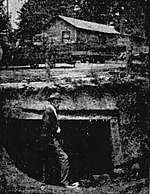Deep River Camelback Truss Bridge
Buildings and structures in Chatham County, North CarolinaFormer road bridges in North CarolinaHistoric American Engineering Record in North CarolinaHistoric Civil Engineering LandmarksNational Register of Historic Places in Chatham County, North Carolina ... and 6 more
Parker truss bridges in the United StatesPedestrian bridges in North CarolinaRoad bridges on the National Register of Historic Places in North CarolinaSteel bridges in the United StatesTourist attractions in Chatham County, North CarolinaTransportation in Chatham County, North Carolina

The Deep River Camelback Truss Bridge is a steel camelback truss resting on stone and concrete piers, with a macadam road surface covering a plank deck. It spans the Deep River in North Carolina, United States between the hamlets of Gulf in Chatham County and Cumnock in Lee County in a quiet rural setting amid woods and farmlands on both sides of the river. It was originally constructed in 1901. The bridge is listed on the National Register of Historic Places. The bridge is open to pedestrian traffic only. Vehicles may use a replacement bridge located about a hundred yards east of the historic structure.
Excerpt from the Wikipedia article Deep River Camelback Truss Bridge (License: CC BY-SA 3.0, Authors, Images).Deep River Camelback Truss Bridge
Camelback Truss Bridge,
Geographical coordinates (GPS) Address External links Nearby Places Show on map
Geographical coordinates (GPS)
| Latitude | Longitude |
|---|---|
| N 35.570277777778 ° | E -79.241111111111 ° |
Address
Camelback Truss Bridge
Camelback Truss Bridge
27256
North Carolina, United States
Open on Google Maps




